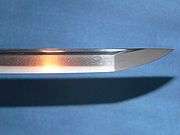Tachi
%2C_A_back_view_of_Onikojima_Yatar%C3%B4_Kazutada_in_armor_holding_a_spear_and_a_severed_head.jpg)
A tachi (太刀) was a type of traditionally made Japanese sword (nihonto) worn by the samurai class of feudal Japan. The tachi style of swords preceded the development of the katana—the first use of the word katana to indicate a blade different from tachi appears toward the end of the twelfth century.[1]
Chokutō, straight swords, were also called tachi, but written as 大刀.[2]
History and description

The production of swords in Japan is divided into specific time periods:
- Jōkotō (ancient swords, until around 900)
- Kotō (old swords from around 900–1596)
- Shintō (new swords 1596–1780)
- Shinshintō (new new swords 1781–1876)
- Gendaitō (modern swords 1876–1945)[3]
- Shinsakutō (newly made swords 1953–present)[4]
Authentic tachi were forged during the Kotō period, before 1596.[5] With a few exceptions, katana and tachi can be distinguished from each other if signed by the location of the signature (mei) on the tang. In general the signature should be carved into the side of the tang that would face outward when the sword was worn on the wielder's left waist. Since a tachi was worn cutting edge down, and the katana was worn cutting edge up the mei would be in opposite locations on the tang of both types of swords.[6]
An authentic tachi that was manufactured in the correct time period averaged 70–80 centimeters (27 9/16 - 31 1/2 inches) in cutting edge length (nagasa) and compared to a katana was generally lighter in weight in proportion to its length, had a greater taper from hilt to point, was more curved with a smaller point area.[7]
Unlike the traditional manner of wearing the katana, the tachi was worn hung from the belt with the cutting-edge down,[8] and was most effective when used by cavalry.[9] Deviations from the average length of tachi have the prefixes ko- for "short" and ō- for "great, large" attached. For instance, tachi that were shōtō and closer in size to a wakizashi were called kodachi. The longest tachi (considered a 15th-century ōdachi) in existence is more than 3.7 metres (12 ft) in total length with a 2.2 metres (7 ft 3 in) blade, but believed to be ceremonial. In the late 1500s and early 1600s many old surviving tachi blades were converted into katana by having their original tangs cut (o-suriage), the signature would be lost in this process.[10]
For a sword to be worn in "tachi style" it needed to be mounted in a tachi koshirae. The tachi koshirae had two hangers (ashi) which allowed the sword to be worn in a horizontal position with the cutting edge down.[11] A sword not mounted in a tachi koshirae could be worn tachi style by use of a koshiate, a leather device which would allow any sword to be worn in the tachi style.[12]
Use

According to author Karl F. Friday, before the 13th century there are no written references or drawings etc. that show swords of any kind were actually used while on horseback.[13]
The uchigatana was derived from the tachi and was the predecessor to the katana as the battlesword of feudal Japan's bushi (warrior class), and as it evolved into the later design, the tachi and the uchigatana were often differentiated from each other only by how they were worn, the fittings for the blades, and the location of the signature (mei).
As a result of the first Mongol invasions of Japan in 1274, tachi started to be made thicker and wider.[14]
In later Japanese feudal history, during the Sengoku and Edo periods, certain high-ranking warriors of what became the ruling class would wear their sword tachi-style (edge-downward), rather than with the scabbard thrust through the belt with the edge upward.[15]
With the rising of statism in Shōwa Japan, the Imperial Japanese Army and the Imperial Japanese Navy implemented swords called shin and kai guntō, which were worn tachi style (cutting edge down).[16]
Gallery
|
See also
References
- ↑ Turnbull, Stephen (8 February 2011). Katana: The Samurai Sword. Osprey Publishing. p. 22. ISBN 978-1-84908-658-5.
- ↑ "太刀・大刀". Daijirin at kotobank.jp (in Japanese). Retrieved July 22, 2015.
- ↑ Clive Sinclaire (1 November 2004). Samurai: The Weapons and Spirit of the Japanese Warrior. Lyons Press. pp. 40–58. ISBN 978-1-59228-720-8.
- ↑ トム岸田 (24 September 2004). 靖国刀. Kodansha International. p. 42. ISBN 978-4-7700-2754-2.
- ↑ Nagayama, Kōkan (1997). The Connoisseur's Book of Japanese Swords. Kodansha International. ISBN 978-4-7700-2071-0., page 48
- ↑ 土子, 民夫; 三品, 謙次 (May 2002). 日本刀21世紀への挑戦. Kodansha International. ISBN 978-4-7700-2854-9., page 30
- ↑ 寒山, 佐藤 (1983). The Japanese Sword. Kodansha International. ISBN 978-0-87011-562-2., page 15
- ↑ Nippon-tô: the Japanese sword, Author Inami Hakusui, Publisher Cosmo, 1948, Original from the University of Michigan, Digitized May 27, 2009 P.160
- ↑ "A distinguished collection of arms and armor on permanent display", Issue 4 of Bulletin, Los Angeles County Museum of Natural History History Division, Ward Ritchie Press, 1969. Original from the University of Virginia, Digitized Aug 13, 2010 P.120
- ↑ The connoisseur's book of Japanese swords, Author Kōkan Nagayama, Edition illustrated, Publisher Kodansha International, 1998, ISBN 4-7700-2071-6, ISBN 978-4-7700-2071-0 P.48
- ↑ Art of the samurai: Japanese arms and armor, 1156-1868, Authors Morihiro Ogawa, Kazutoshi Harada, Publisher Metropolitan Museum of Art, 2009, ISBN 1-58839-345-3, ISBN 978-1-58839-345-6 P.193
- ↑ Pauley's Guide - A Dictionary of Japanese Martial Arts and Culture, Author Daniel C. Pauley, Publisher Samantha Pauley, 2009, ISBN 0-615-23356-2, ISBN 978-0-615-23356-7 P.91
- ↑ P.84
- ↑ The Japanese Sword, Kanzan Satō, Kodansha International, 1983, ISBN 0-87011-562-6, ISBN 978-0-87011-562-2 P.54
- ↑ Kapp, Leon; Hiroko Kapp; Yoshindo Yoshihara (1987). The Craft of the Japanese Sword. Japan: Kodansha International. p. 168. ISBN 978-0-87011-798-5.
- ↑ The Japanese Army 1931-42, Volume 1 of The Japanese Army, 1931-45, Author Philip S. Jowett, Publisher Osprey Publishing, 2002, ISBN 1-84176-353-5, ISBN 978-1-84176-353-8 P.41
External links
| Wikimedia Commons has media related to tachi. |
| Wikimedia Commons has media related to Nihonto. |
_tachi_tsuka.jpg)



.png)
